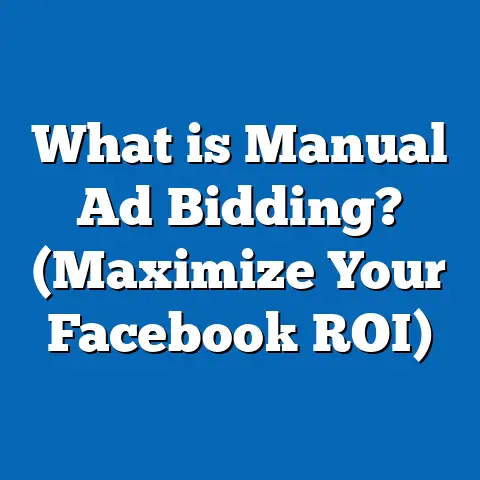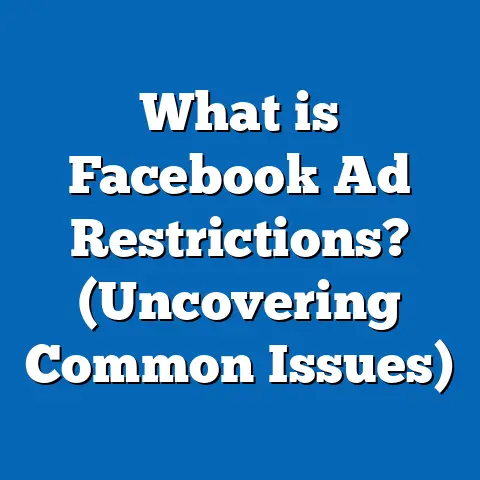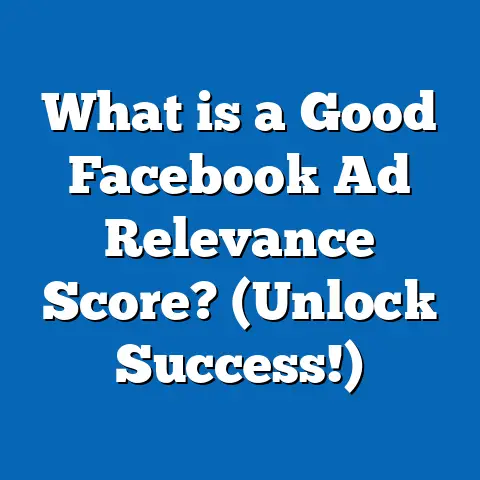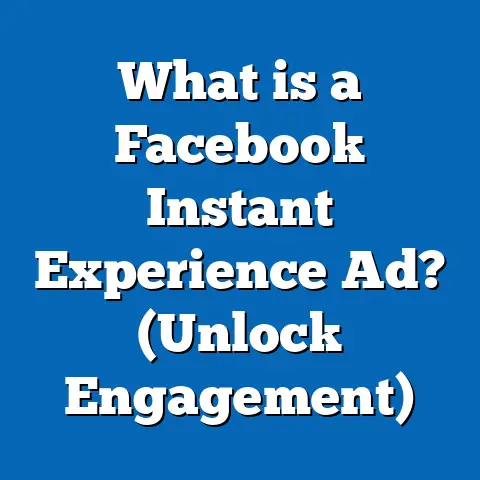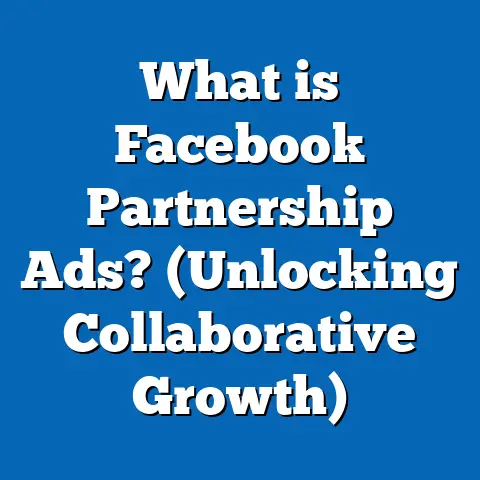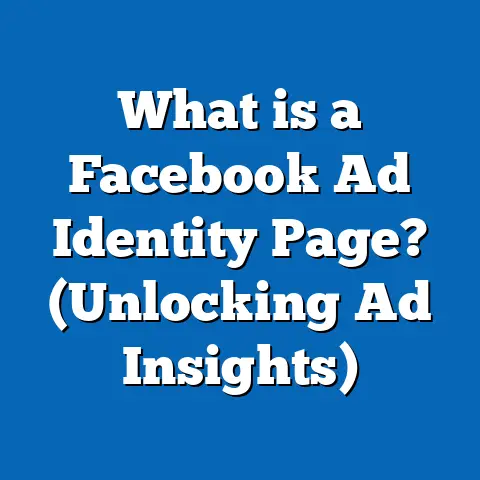What is Facebook Ad Boost? (Unlocking Instant Reach Strategies)
Introduction: Harnessing the Power of Facebook Ad Boost for Energy Savings and Beyond
Energy savings and efficient resource management are crucial in both personal and business contexts. Just as optimizing energy usage reduces costs and environmental impact, optimizing your marketing spend to get maximum return is essential. Facebook Ad Boost is a tool that helps businesses do just that by allowing marketers to instantly expand their content’s reach and engagement with minimal effort and budget.
In a crowded digital marketplace, standing out quickly can make the difference between success and obscurity. Facebook Ad Boost offers an accessible gateway to advertise smartly without the steep learning curve of complex ad campaigns. Whether you want to promote a sale, increase website traffic, or grow your follower base rapidly, understanding how to unlock Facebook’s instant reach strategies will empower you to drive results effectively.
What Is Facebook Ad Boost? Breaking Down the Basics
Definition of Facebook Ad Boost
Facebook Ad Boost refers to the process of “boosting” a post on your Facebook page by paying to show it to a wider audience beyond your current followers. When you boost a post, it essentially becomes a paid advertisement, displayed across Facebook’s network targeting users based on demographics, interests, location, and behavior.
Unlike building an ad campaign from scratch in Facebook’s Ads Manager—which requires extensive setup and strategy—boosting is designed as a fast, user-friendly way to get immediate exposure with just a few clicks.
Types of Posts You Can Boost
Almost any content you publish on your Facebook page can be boosted:
- Photos and videos
- Status updates
- Link posts (directing users to websites or landing pages)
- Event promotions
- Offers or discounts
Choosing which posts to boost depends on your marketing goals and which content resonates best organically.
How Boosting Differs From Organic Reach
Organic reach is the number of people who see your content naturally through their newsfeed because they follow your page or interact with similar content. Organic reach has declined significantly over recent years due to Facebook’s algorithm prioritizing paid content and personal user connections.
Boosting posts ensures your content reaches people who don’t follow your page but fit your target audience profile. This paid method bypasses organic limitations and delivers faster results.
Quick Advantages Summary
- Easy setup without technical skills
- Immediate increase in post visibility
- Budget control with small minimum spends
- Basic targeting options for relevant reach
- Suitable for quick promotions and announcements
Why Is Facebook Ad Boost Important? Data-Backed Insights
The Decline of Organic Reach
Facebook has publicly stated that organic reach for business pages has dropped below 5% on average. For example:
- A 2023 study by Social Media Examiner revealed that average organic reach per post across industries was only 4.7%.
- This decline means businesses must rely more on paid strategies to maintain visibility.
Impact of Boosted Posts on Engagement and Reach
Data from various industry sources shows:
- Boosted posts can increase reach by up to 300% compared to organic posts.
- Engagement rates (likes, shares, comments) on boosted posts increase by an average of 25-35%.
- Small businesses using boosted posts report an average 15-20% boost in follower growth monthly.
Cost Effectiveness Compared to Other Paid Channels
According to WordStream’s Facebook Advertising Benchmarks (2024):
| Industry | Average Cost Per Click (CPC) | Average Cost Per Engagement (CPE) |
|---|---|---|
| Retail | $0.70 | $0.15 |
| E-commerce | $0.85 | $0.20 |
| Real Estate | $1.20 | $0.30 |
| Small Businesses | $0.40 | $0.10 |
Boosted posts typically fall on the lower end of these costs because they leverage existing organic content proven to resonate with audiences.
Case Study Snapshot: Small Business Success
A local boutique in Texas boosted weekly product highlight posts targeted at women aged 25-44 within a 20-mile radius. Over three months:
- Reach increased by 270%
- Website visits from Facebook rose by 180%
- Sales attributed to boosted posts accounted for 30% of total monthly revenue
- Average cost per sale was $10, compared to $18 for other ad campaigns
How Facebook Ad Boost Works: Step-by-Step Process Explained
Step 1: Select the Post You Want to Boost
Start by choosing a high-performing post from your page timeline. Posts with strong organic engagement (likes, comments, shares) tend to perform better once boosted because they already capture attention.
Step 2: Define Your Audience
You can target:
- Local or regional audiences: Specify countries, cities, or even a radius around a location.
- Demographics: Age range, gender, language.
- Interests: Based on hobbies, pages liked, shopping habits.
- Behaviors: Purchase behavior, device usage.
- Custom Audiences: Upload email lists or target website visitors via Facebook Pixel.
- Lookalike Audiences: Target users similar to your best customers.
Facebook’s algorithm uses this data to optimize delivery for best performance.
Step 3: Set Budget and Duration
You control:
- Daily or lifetime budget: Minimum as low as $1 per day.
- Duration: From 1 day up to several weeks.
Facebook estimates potential reach based on your budget and audience size.
Step 4: Add Payment Information and Launch
Once everything is set, confirm payment details. Your boosted post will start running shortly after approval.
Step 5: Monitor Performance & Optimize
Use Facebook Insights or Ads Manager dashboard to track:
- Reach
- Engagement
- Clicks
- Cost per result
Adjust budget or targeting if needed during the campaign.
Targeting Strategies for Maximum Impact with Facebook Ad Boost
Using Core Audiences
Core audiences rely on demographic data such as:
- Location (country, city, zip code)
- Age & gender
- Languages spoken
- Interests (e.g., fitness enthusiasts, tech buyers)
This broad approach is excellent for initial market testing or brand awareness campaigns.
Custom Audiences for Precision Marketing
Custom audiences allow you to target:
- Existing customers via email lists
- Website visitors tracked through Facebook Pixel
- Users who engaged with previous posts or videos
This strategy improves conversion by focusing on warm leads already familiar with your brand.
Lookalike Audiences to Expand Reach Smartly
Lookalike audiences find new users resembling your best customers based on shared characteristics. This helps scale campaigns while maintaining relevance.
Exclusion Targeting: Avoid Waste
Exclude certain groups such as:
- Current customers when aiming for new acquisitions.
- Users who already converted.
This saves budget and increases efficiency.
Creative Best Practices for Boosted Posts
Visual Content Optimization
Posts with compelling visuals get higher engagement:
- Use high-quality images or videos.
- Videos under 30 seconds tend to perform better.
- Incorporate brand colors and logos subtly.
Crafting Clear Calls-to-Action (CTAs)
Effective CTAs guide users towards desired actions such as:
- “Shop Now”
- “Learn More”
- “Sign Up Today”
Make CTAs visible and aligned with campaign goals.
Caption Writing Tips
Keep captions concise but engaging:
- Ask questions or encourage interaction.
- Use emojis sparingly but effectively.
- Highlight benefits or offers clearly.
Timing Your Boosts: When Should You Promote Posts?
Using Facebook Page Insights, analyze when your audience is most active:
- Many pages see peak activity between 6 pm – 9 pm weekdays.
- Weekends may vary depending on industry; retail businesses often find Saturday afternoons effective.
Scheduling boosts during these peak times can improve visibility and engagement rates.
Integrating Facebook Ad Boost Into Broader Marketing Campaigns
Using Boosted Posts as Top-of-Funnel Awareness Tools
Boosted posts create awareness by reaching large audiences quickly. This primes users for more targeted ads later in the funnel.
Retargeting Engaged Users With Custom Ads
People who engage with boosted content can be retargeted with more personalized ads such as product offers or sign-up forms.
Driving Conversions Through Sequential Campaigns
Example funnel flow:
- Boost Post: Introduce product/service → gain broad interest.
- Retarget Ads: Show testimonials or discounts → increase consideration.
- Conversion Ads: Present purchase options or limited-time offers → close sales.
Comparing Facebook Ad Boost With Other Platforms and Services
| Platform/Service | Ease of Use | Targeting Precision | Cost Efficiency | Best Use Case |
|---|---|---|---|---|
| Facebook Ad Boost | Very simple | Moderate | High for small budgets | Quick reach & engagement |
| Facebook Ads Manager | Complex | Very high | Scalable | Advanced targeting & funnels |
| Instagram Ads | Moderate | High | Comparable | Visual & influencer marketing |
| Google Ads | Complex | Very high | Variable | Search intent & conversions |
| LinkedIn Ads | Moderate | High (B2B focus) | Higher cost | B2B lead generation |
Facebook Ad Boost stands out for its simplicity and instant results but lacks the detailed control found in Ads Manager or Google Ads.
Key Metrics Explained: How to Measure Success With Facebook Ad Boost
Reach vs Impressions
- Reach: Number of unique users who saw your post.
- Impressions: Total number of times your post was shown (including multiple views per user).
Reach tells you how many different people saw your content; impressions show overall exposure volume.
Engagement Rate
Engagement includes likes, comments, shares, clicks. Engagement rate = (Total Engagement / Reach) × 100%.
Higher engagement rates indicate content relevance and audience interest.
Click-through Rate (CTR)
CTR = (Clicks / Impressions) × 100%. This metric shows how compelling your post’s call-to-action is.
Cost Per Result (CPR)
CPR = Total Spend / Number of Desired Actions (clicks, conversions). Lower CPR indicates cost efficiency.
Return on Ad Spend (ROAS)
ROAS = Revenue Generated from Ads / Amount Spent on Ads. ROAS above 1 means profitable campaigns.
Common Challenges Marketing Professionals Face With Facebook Ad Boost—and How to Solve Them
Challenge 1: Limited Audience Size Restricts Growth
Solution: Use lookalike audiences based on existing customers to expand relevant reach gradually without losing targeting precision.
Challenge 2: Post Content Not Resonating With Target Audience
Solution: Perform A/B testing by boosting multiple posts with different creatives/copy; analyze which performs best before scaling budget.
Challenge 3: Difficulty Tracking Conversions Beyond Engagement
Solution: Implement Facebook Pixel on your website for granular tracking of sales, sign-ups, or other goals influenced by boosted posts.
Challenge 4: Budget Exhaustion Without Desired Results
Solution: Start small; use audience exclusion; focus budget on highest-performing boosts identified through analytics reviews.
Real-Life Case Studies Illustrating Effective Use of Facebook Ad Boost
Case Study 1: Local Fitness Studio Growth Through Event Promotion
A fitness studio in Chicago boosted event posts promoting free trial classes targeted at adults aged 25-45 within a 10-mile radius.
Results after 2 months:
- Event RSVPs increased by 150%
- New memberships rose by 40%
- Cost per signup was $8 compared to $15 for paid search ads
This demonstrates how boosted event promotion can drive offline conversions effectively.
Case Study 2: E-Commerce Brand Product Launch Success
An online skincare brand boosted posts announcing new product launches targeted at women aged 18-35 interested in beauty products globally.
Results over one launch cycle:
- Reach grew by 400%
- Website traffic from Facebook surged by 220%
- Sales from boosted posts accounted for 28% of total monthly revenue
This highlights how boosting can rapidly generate buzz during critical product launches.
Advanced Techniques: Leveraging Technology and Data for Better Results
Utilizing Facebook Pixel Data for Smarter Targeting
Facebook Pixel tracks user actions on your website after clicking ads or boosted posts. This data enables:
- Retargeting visitors who didn’t convert
- Creating custom audiences based on past behavior
- Optimizing campaigns toward actions like purchases or sign-ups rather than just clicks
Proper Pixel setup maximizes ROI from boosted posts integrated with website conversion goals.
Using UTM Parameters for Detailed Campaign Tracking
Add UTM parameters to links in posts before boosting them. This allows you to track traffic sources in Google Analytics precisely, measuring:
- Which boosted posts drive most visits
- Behavior of visitors coming from boosts versus organic channels
- Conversion rates linked directly to specific boosts
Example UTM parameter:https://yourwebsite.com/product?utm_source=facebook&utm_medium=boost&utm_campaign=summer_sale
Staying Ahead: Latest Trends and Features in Facebook Advertising (2024 Update)
New Targeting Enhancements
Facebook now offers AI-driven audience suggestions that dynamically adjust targeting based on campaign performance — improving boost outcomes without manual intervention.
Video Boosting Gains Popularity
Short-form videos under 15 seconds are increasingly effective when boosted due to better engagement rates and mobile user preferences.
Integration With Instagram Shopping Features
Boosted posts can now link directly to Instagram Shopping catalogs allowing seamless cross-platform commerce experiences for users browsing products.
Practical Action Plan: How To Start Using Facebook Ad Boost Today
- Audit your existing content—identify top-performing organic posts.
- Define clear goals—brand awareness, lead generation, sales conversion.
- Choose audience segments leveraging core/custom/lookalike audiences.
- Set small initial budgets ($5-$10/day) for testing.
- Launch boosts with optimized creatives and CTAs.
- Monitor results daily; pause underperforming boosts quickly.
- Use insights to refine targeting and messaging continuously.
- Scale successful boosts gradually while integrating retargeting campaigns.
- Track conversions using Pixel & UTM parameters.
- Stay updated on platform changes; test new formats regularly.
Conclusion: Unlocking Instant Reach Strategies Through Facebook Ad Boost
Facebook Ad Boost is an essential tool that bridges the gap between organic social media marketing and full-scale paid advertising campaigns. Its simplicity makes it accessible even for beginners while offering powerful targeting options that deliver quick wins.
By understanding how boosting works, leveraging data-backed insights, applying advanced targeting techniques, optimizing creatives, and integrating boosts into broader marketing funnels, businesses can unlock instant reach strategies that save time and money while driving real growth.
The key lies in continuous testing, learning from analytics, and refining approaches based on audience response—all while staying current with evolving platform features.
With these strategies in place, marketing professionals and business owners can confidently use Facebook Ad Boost not just as a temporary tactic but as a core component of their digital marketing ecosystem moving forward into 2025 and beyond.
If you want me to add detailed tutorials on setting up Facebook Pixel or integrating Instagram Shopping with boosted posts next, just ask!

